The flooring of an inflatable boat is an important factor to consider, since each floor type has it’s uses, pros and cons. The 4 types of flooring you’ll encounter in inflatable boats are:
- roll up floors
- hard floors
- air floors
- rigid floors in RIBs
Contents
Roll-up slat floor
The most basic inflatable boat floor type is the roll-up floor, also known as slat floor.
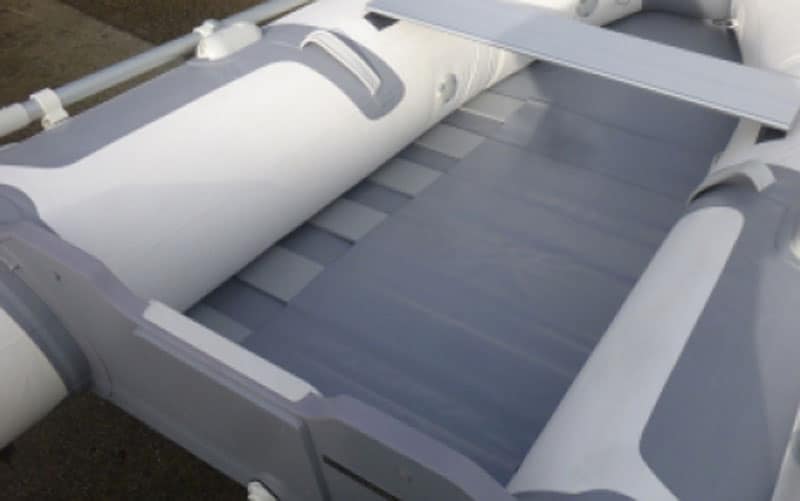
As you can see on the image above, the roll-up floor is made up of lateral slats with gaps in between each slat. The slats are made of various materials such as aluminium or wood.
The slat floor is easy to assemble, roll up and store, however, they are not that rigid, making them somewhat hard to stand on.
Inflatable boats that use slat flooring are designed with simplicity in mind. They are great for short trips, but lack performance in choppy waters and while turning.
The size of inflatable boats that use roll-up floors varies from about 5 feet (carries 1 person) to 9 feet (carries 4 people).
- easy to roll up and carry
- storage in relatively small spaces
- less expensive than hard floor
- lack of rigidity
- hard to stand on
- broken slats can damage fabric thus prone to tears
- usually no keel
Hard floor
Inflatable boats with a hard floor offer higher durability and increased performance over slat floored boats. This type of floor is also made of aluminium or wood.
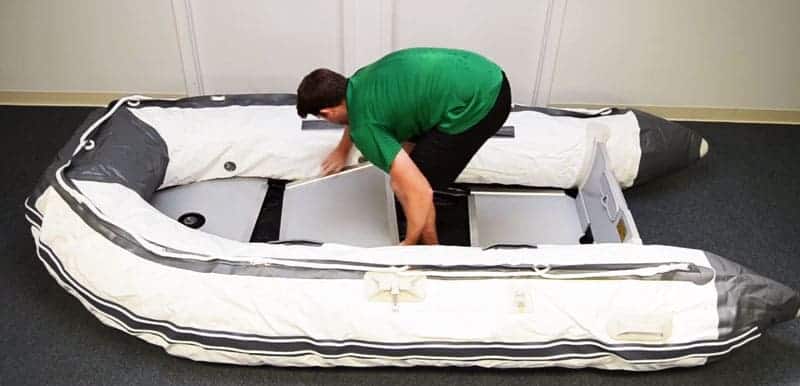
The hard floor makes the craft rigid and more durable than roll-up floors. You can think of hard floors as the backbone of the boat, providing more rigidity and stability.
The added rigidity allows the use of inflatable V-shaped keels, which run along the bottom of the boat. The combination of the hard floor and keel makes maneuvering and turning easy (even in choppy waters) and allows the boat to get on plane.
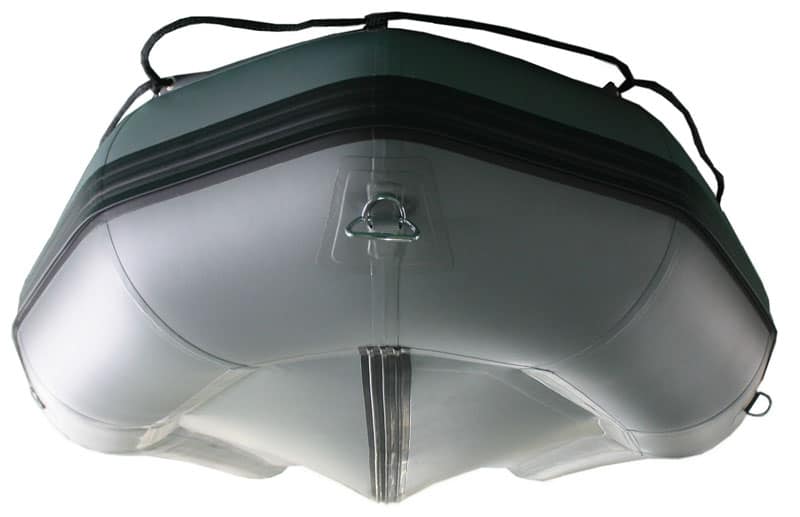
The added versatility of hard floor inflatable crafts give them the ability to be used for many things, including fishing boats, yacht tenders, dive boats, and more.
The size of hard floor inflatable boats can vary from 7 feet to 23 feet.
- durable
- stable
- versatile
- more expensive
- longer time to assemble
- harder to carry and store
Air floor (air deck)
A modern air floor is a separate flat tube, which inflates just like the larger side tubes.
Air floors allow for high pressure inflation (often inflated to 8-12 psi), making them rigid enough to stand and even jump on, yet weigh considerably less than a hard floor boat.
Of course, they will not be as stiff as hard floors, and will allow for some flex.
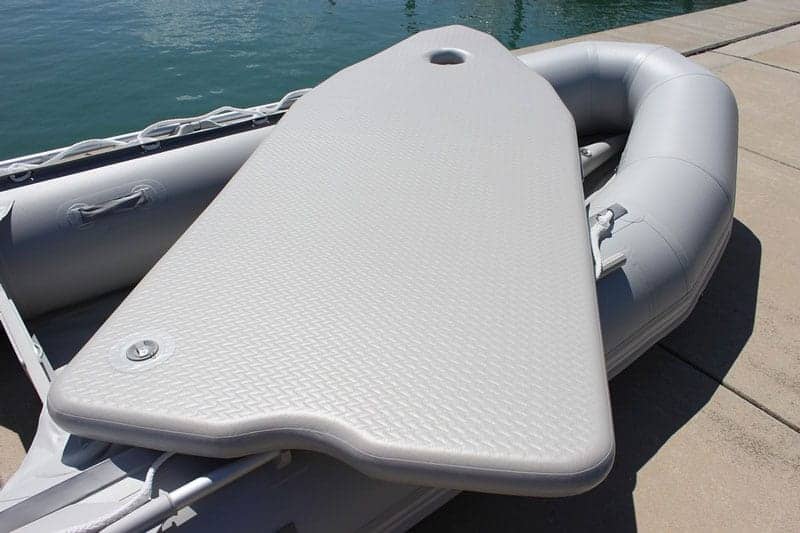
Air floors are made of very tough material, which makes them more expensive than hard floors. They are constructed from specially designed drop-stitched PVC, often called Double Wall Fabric. The 2 sides of the air floor are held together by thousands of interwoven stitches.
They are easy to store, since they can simply be deflated and wrapped up with the boat itself. This is an important consideration for a lot of people who choose an inflatable boat.
Like hard floors, inflatable keels are used in conjunction with air floors, giving these boats better maneuverability. However, their reduced weight and higher center of gravity will make them less stable at higher speeds.
Another advantage air floors have over hard floors is that they are soft. Sitting or kneeling on air floors is much more comfortable, especially for kids in the boat.
If you buy an inflatable boat with an air floor, keep in mind that water temperature has an effect on the air pressure in the floor. If the water is cool, the air will condense, so you may need to inflate more air into it.
TIP: If you plan on using your boat for fishing or carrying things around, you can avoid puncturing the air floor by laying a cut-to-shape vinyl piece or carpet onto the floor.
- additional buoyancy
- stable
- saves weight and storage space
- portable
- easier and faster to assemble than hard floor
- comfortable for sitting/kneeling
- reduced weight means less stability
- more expensive
- can’t mount anything onto it, like you could on aluminum or wooden panels (think fish finder, real seat, etc.)
Cheaper inflatable rafts that are used as toys also have an air floor, but they are simple ribbed inflatable tubes mostly suitable for playing on the water.
RIBs
RIB is an abbreviation for rigid hulled inflatable boat. This means that the hull (bottom) of the inflatable boat is constructed like a traditional boat.
With this come advantages and trade-offs, which you can read about extensively in this article.
Self-bailing floor
Self-bailing floors are also a feature you might want to consider.
Non-bailing standard floors have the flooring sealed to the tubes, which means that water splashed into the boat stays there until scooped out.
Self-bailing floors, on the other hand, have holes located on the sides of the floor. The water that gets splashed into the cockpit exits through these wholes.
This is especially useful in situations where you would expect a lot of water to enter the cockpit, like white-water rafting.
Which floor type is best?
Now you know the specifics of all 4 floor types an inflatable boat may come with, you probably have an idea of which one you would prefer.
Each type has it’s advantages and disadvantages, so choosing may not be easy.
Here are a few things you should consider:
- What you will be using your boat for? Going fast requires a boat with a keel. Whitewater rafting requires a based self-bailing floor that is not rigid. Taking the kids around the lake is best with a comfortable air floor. Fly fishing from an inflatable raft is best with a hard floor where the angler can easily stand and balance.
- Where you will use the boat? Flat water? Running river? Choppy sea?
I have owned inflatable boats with all kinds of floors. In general, I’ve found that:
- Drop stitched air floors are the most comfortable for riding in and in terms of storage, but also the most expensive.
- Hard floors are best for going fast with an outboard motor. They don’t flex and are stable. They do require an extra few minutes to set up, but once you get into it, it’s not that bad. Just make sure your trunk is big enough to put them in when disassembled, if you plan on moving it around of course.
- Slated roll up floors are the least expensive choice. They don’t require much care, but of course, there is a trade off. They are the least stable on the water. Some roll up floors where the slates are very close together are OK, but the ones that are further apart are pretty unstable.
The floor type available to you also depends on the type of inflatable boat you get. All of the above floorings are available for inflatable dinghies and sports boats. Inflatable pontoon boats don’t have any of the above floor types, you would stand on their metal frame. Inflatable kayaks have air floors only.
I hope this helps, please let me know if you have any questions or comments in the comment section below.

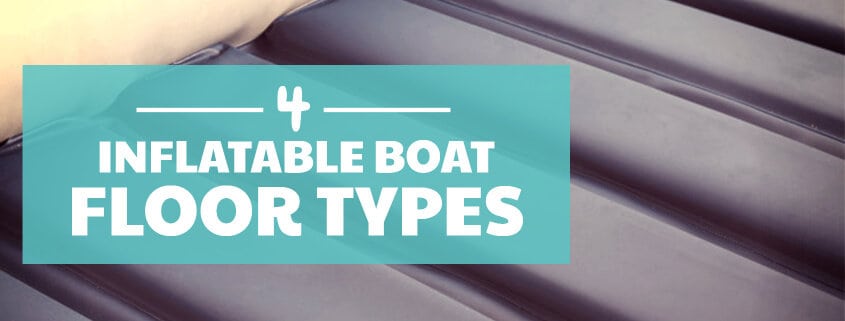
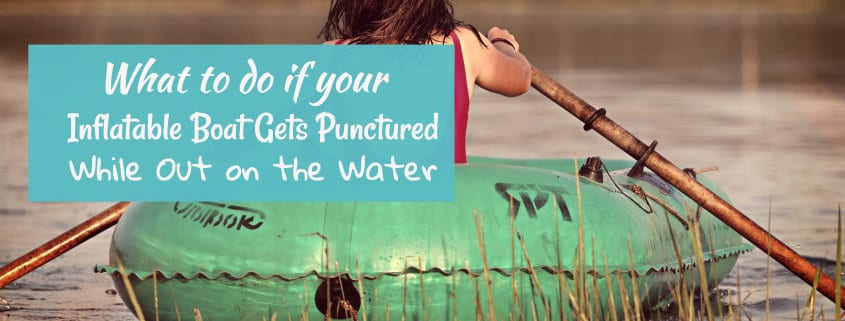
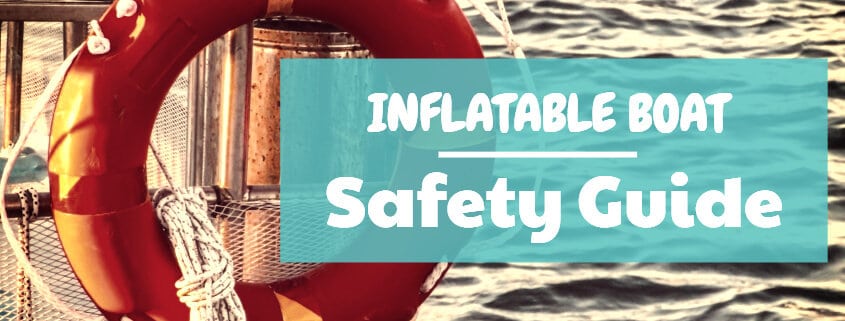

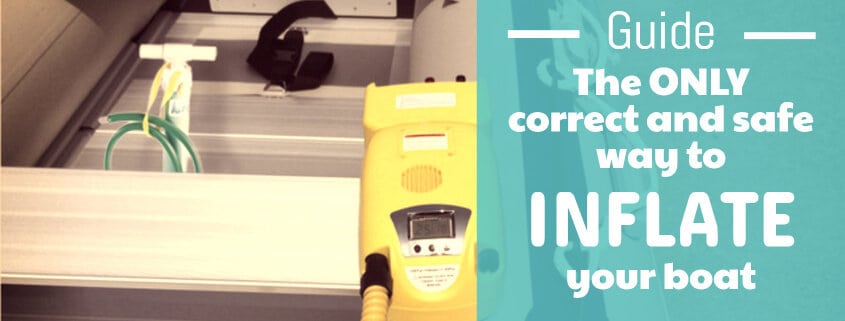
We have a 3.1m Ribeye rib which is a tender to our sailing yacht. The aluminium internal floor is v-shaped and quite difficult to step into (we are both retired). We’d like to make the internal floor flat for ease of stepping in and out of. How would you recommend we do this? What material would you suggest we use to do this?
You would need to build a flat hard floor, here is a tutorial on the process.
Thank you for your information on Inflatables.
Can you please a comment on the inside depth pertaining to the 4 floor type differences.
Regards
Frank
The depth of the floor varies by the manufacturer of the boat. Roll up floors are the thinnest, followed by hard floors, and finally high-pressure drop stitched air floors.
Hello,
I love your website and the through and comprehensive information you provide. This was one prime source of information for getting our family into boating :). We got a Intex Seahawk 4 to get our family in the water. We thoroughly enjoyed and upgraded to a buying a used aluminum 15′ which we have enjoyed. I’m considering going back to an inflatable boat and struggling to decide between an aluminum sectional hard floor vs. a RHIB. I’m familiar with the pros and cons as I have read/researched, except for the ride. There is no way for us to test/experience the ride. We have a 6yr old and a 2yr old. My wife feels inflatables might be bumpy for them.
– Will I be compromising too much on ride quality moving from a regular AL boat to a RHIB to a hard floor sectional?
– With a RHIB, are double floors lot better than single floors? For example, Classic vs Ultralite with Highfield.
– What is a reasonable recommended length for say 3-4 adults and two less than 10yr olds?
Kal
Hi there, a RIB is not a compromise vs a full aluminum boat. I think it is a better option.
The hard floor boats are more comfortable for being in, and they keep the boat more rigid vs a soft inflatable floor. But the hull design of the RIB is another ball game, not comparable to a simple hard floor inflatable boat.
As for the single vs double floor RIB, a single-floor RIB weighs less, but the floor is shaped like a V, so it isn’t as stable under foot as a double-floor RIB, which has a flat deck.
Hi.
I have a slatted floor inflatable boat. Can you sit on the slats as there’s only one bench on boat. ? Or can you put inflatable cushions on slatted floor.
First let me say I LOVE your website…I’m huge detail person, and I appreciate all your work. Coming from an old Apple Level III Tech then Operations Director.
Preface before my question…as to perhaps explain my mindset…
My wife and I currently own four (4) types of inflatables…
1) We have a Saturn XD430 (which you may already be familiar with)…it’s a 14′ Long Tender which has a full-length drop stitch high compression floor. I got it specifically because it had the longest drop stitch floor I could find as our kids are all in their 20’s now, so some of my thoughts and justification behind its purchase…was potential grandkids down the road, way further down the road. 😉 While still being able to put it in my Honda Accord Hybrid or my wife’s Ridgeline. Plus, maybe someday getting an ePropulsion outboard (okay just dreaming).
2) We have two (2) 13′ Advanced Elements AdvancedFrame Expedition Elite Kayaks that also have have high compression drop stitch floors (can you see my pattern?) 😉 And we love those…I got a killer sale of $650 each, and we like them WAY better than any hard sided kayak (again just stick them in the car and go with no trailer and no roof rack).
3) We used to have a lil’ 2/3 person Intex Challenger that finally gave up the ghost after 20+ years. My wife had originally bought it for about $35 (thinking it would not even last 1 summer). But instead, that crazy thing lasted our 3 kids growing up; going camping; and floating down rivers w/Class II+ rapids in places. Well, when it died, my wife wanted to get another “smaller raft”…again, just for floating those same rivers with her girl friends. And being that she wanted “cheap”, I replaced it with Intex Challenger 3 in the Summer of 2018. We were purposefully going for “cheap lil’ replacement” at the time, but in retrospect…if I had done more research (like I normally do). I would have gotten my wife an Intex Mariner 3, oh well.
4) Okay, so last but not least when the kids were small (10+ years ago). I’d bought a Sevylor Fish Hunter HF 360 (thinking it would fit the whole family). Well, it was sooooo big and bulky, and with soooooo little interior space…that Fish Hunter HF 360 hardly ever got used. It would only come out of its box if my wife was floating down the river with 3 or 4 ladies. Well, we just decided to put the Fish Hunter HF360 up for sale because we just hardly every use it (plus I keep things perfect) and value wise they seem to sell for about $200 around here. So….I bought a brand new Intex Mariner 4 after watching and reading your reviews along with many others, as well. And I have to say that Mariner 4 is a FANTASTIC boat. It is built, and it has sooooo much interior room for its external dimensions…it is really a “sweet spot size” for all kinds of activities…not too big and not too small, like Goldilocks. 😉
So it is the Intex Mariner 4 that finally brings me to my multi-pronged questions to you with all your experience!
A) Have you found any sources for after market drop stitch floors? My wife is not a huge fan of how heavy the ‘slated floor’ is in the Mariner 4…so I thought if there was a drop stitch floor that would fit in the Mariner 4…seems like that would be a super fantastic upgrade to an already great boat…with it’s main purpose being a raft that just floats down rivers with occasional Class II+ Rapids with mostly calm in-between.
B) I’d love your feedback on if you think the Mariner 4 is safe and/or strong enough to use without the slatted flooring in it? I called Intex, but they were no help at all.
So anyway, I ask because I’ve read other Amazon reviews were people suggested to NOT have any air in the keel, so that the floor would be more like a White Water Raft (i.e. flatter on the bottom), as to help not rip the floor over rocks. But then I’ve read other reviews where folks indicated that they felt the slatted floor was a contributor to causing rips as they floated down river, too. Again we are NOT die hard white water rapid people, and I realize we are not using the Mariner 4 for its perhaps more intended fishing purposes on a lake.
Anyway, I hope my questions make sense?!
Thanks for your diligence and time!
Hi there, thanks for your comment, I’m glad you are finding my articles useful!
By the way, I just tried an ePropulsion outboard fitted on a normal fiberglass boat last week in Hungary, it was sweet 🙂 But it’s a bit overkill. It used 48V lithium batteries…
So about the Mariner 4, it is my favorite raft, as you already know. It isn’t a whitewater raft though. I mean I would trust it on level 2 rapids, but not on level 3. Not self-bailing, so the water coming in would be an issue there (among other things).
If you do approach rapids, I would deflate the keel as well, and pump it back up afterward with my trusty K-Pump Mini 🙂
If you want to make the edges of the slatted floor easier on the boat, get insulation tubes and line it along the edge of the floor. Sort of how I described in the DIY hard floor article. That should dampen the edges enough as to not let it harm the rubber. I have not heard of anybody using a high PSI air floor with the Mariner, I don’t think you can have them custom made.
By the way, I just found this video of a Mariner 4 going through rapids, it’s worth a watch. It handled quite well I think, but because of the swivel chair, I’m guessing they have a purpose-built hard floor.
https://www.youtube.com/watch?v=oZq2s-MfUXE
I’m thinking of making my slat floor more rigid by fashioning port and starboard stringers out of ABS pipe, cutting a lengthwise slot to fit over the edge of the slats. Any thoughts or cautions?
I have never tried this, so can’t say for certain. Thinking about it though, I can imagine it would make the floor more rigid, but you would need to add a dampener to the end of the pipes to not allow it to cause any damage to the tubes.
My main concern is the bottom of the boat. The slat floor is being pushed down with excess force at the ends of the pipes. The force at these points might damage the bottom of the boat where it is being pushed down, so it might tear outwards. This would also depend on what kind of material the boat is though, and how/where the bottom is sealed to the tubes.